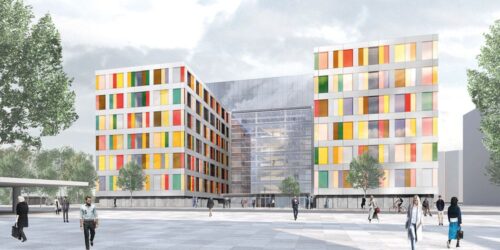n a site steeped in history a few hundred meters from the Reichstag in central Berlin, an office building is rapidly taking shape that handily symbolizes how climate protection has come to dominate the political narrative ahead of September’s election.
The modular Luisenblock West, which will provide working space for Germany’s Bundestag, or lower house of parliament, is mostly wooden beyond a reinforced concrete core. The individual units that make up the bulk of the building are assembled at a site in the east of the city and designed to reduce carbon footprint by capturing thousands of tons of carbon dioxide.
With just four months until the national vote that will mark the end of Angela Merkel’s 16-year reign, the Greens are leading the chancellor’s conservative bloc in some opinion polls and climate protection is high on the list of priorities for many voters. The former fringe party has a real chance of leading a German government for the first time, while traditional parties scramble to affirm their environmental credentials.
Read more: Scholz Counts on Investors to Eradicate CO2 Emissions in Germany
Dozens of new Green lawmakers are likely to enter the Bundestag, and some may be assigned one of the 400 offices in the new block on the opposite bank of the Spree river. About 460 wooden modules are transported from the assembly location in Koepenick, a district in the former communist area of Berlin, delivered during the evening when traffic is lighter.
The seven-story block with its striking multi-colored facade straddles the former route of the Berlin Wall and borders a memorial site for the dozens of people who died trying to escape to the west.
The building, which is due to be officially handed over at the end of the year, stands between the Marie-Elisabeth-Lueders-Haus— named after a 20th-century politician and women’s rights activist — and the Bundespressehaus, where the government holds its thrice-weekly news conferences.
Built at a cost of 70 million euros ($86 million) and designed by architects Sauerbruch Hutton, the building’s wood will capture around 2,500 tons of carbon-dioxide, according to Achim Nagel of the building’s developer Primus.
At the same time, trees will be planted to regrow the same amount of wood used for the building within 15 years, sucking a further 2,500 tons of CO2 from the atmosphere, Nagel added.
The project’s eco-friendly character reflects a wider trend for wooden construction that has already made its mark on the German capital.
Across town in the trendy Kreuzberg district, a 322-foot (98-meter) mixed-use building is under construction that uses engineered wood known as cross-laminated timber. The material allows builders to erect tall towers that use far less steel and concrete than traditional skyscrapers.
Called WoHo and designed by Norway’s Mad Arkitekter, the 29-story building promises to be Europe’s highest wooden structure to date, using reinforced concrete solely for its core and basement.
Read more: Berlin’s New Timber Tower Comes With Lofty Ambitions
Germany’s Federal Office for Building and Regional Planning, or BBR, which oversees government facilities, said it opted for the Luisenblock concept due to its “efficiency and sustainability,” as well as the rapid construction time.





